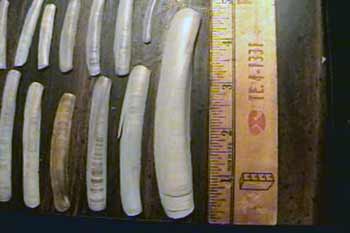


I found this shell on the beach last week, and wanted to share before calling it an evening. It's the first one I've seen this big. Most are half the size, usually smaller.
The shell book I am referring to, lists two species, but none are measuring this size.
"Green Jackknife Clam" Solen viridis, 2" measurement, Rhode Island to Northern Florida and Gulf of Mexico.
and, "Jackknife Clam", Ensis minor, 2-3" measurement, commonly found from Florida to Texas.
Correction:
I'm a constant beachcomber (with a degree in marine biology) and hope I can help you.
What I think you have is the Atlantic jackknife clam (Ensis directus) which is found from Canada to SC and grows to 5 inches.
Terri K. Hathaway
Marine Education Specialist
North Carolina Sea Grant
www.ncseagrant.org
Hello Sharon, I am by no means a mollusk expert but I used to live in Nova Scotia and I think the large razor clam you found may be a common razor clam (Ensis directus) that I remember seeing up there as a child. They get quite large 3-8" in length, ranges from Labrador to South Carolina. And external coloration can vary.
I found this on the www.enature.com website.
Common Razor Clam Ensis directus
enature.com wildlife list speciesID 4771
enature.com imageID 19495
enlarge +
enature.com field guides imageID 19495
Common Razor Clam
© E. R. Degginger
enature.com foto gallery ID 631
Photo Researchers, Inc.
enature.com agencyID=7
Family: Solenidae, Razor Clams view all from this family
enature.com field guides FamilyID 646
Description 3-8" (7.6-20.3 cm) long. Elongately oblong, slightly curved; both ends strongly squared off, front lower corner rounded; umbones at front end; a low, flat, broadening ridge runs from umbones to hind end; ligament moderately long, narrow. Exterior whitish; periostracum olive-green, grayish on ridge; smooth except for fine growth lines that become vertical on ridge, and above it turn back toward umbones.
Interior bluish-white; 2 small, vertical central teeth in left valve, 1 narrow central tooth in right valve; a long side tooth in each valve behind central teeth.
Habitat In sand intertidally.
Range Labrador to South Carolina.
Discussion These clams are common on tidal flats in New England, where they burrow vertically into the sand with their strong foot. They make good eating and are frequently sold in local markets. The related Minor Jackknife Clam (E. minor) is smaller, more slender, and paler; it is found from New Jersey to Florida and Texas.
Interesting webpage you have.
Sincerely,
Tina Moore

No comments:
Post a Comment